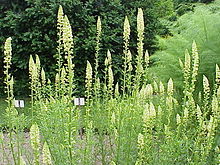
The Brassicales are an order of flowering plants, belonging to the eurosids II group of dicotyledons under the APG II system. One character common to many members of the order is the production of glucosinolate compounds. Most systems of classification have included this order, although sometimes under the name Capparales.

The Vitaceae are a family of flowering plants, with 14 genera and around 910 known species, including common plants such as grapevines and Virginia creeper. The family name is derived from the genus Vitis.

Ceratophyllaceae is a cosmopolitan family of flowering plants including one living genus commonly found in ponds, marshes, and quiet streams in tropical and in temperate regions. It is the only extant family in the order Ceratophyllales. Species are commonly called coontails or hornworts, although hornwort is also used for unrelated plants of the division Anthocerotophyta.

Nyssaceae is a family of flowering trees sometimes included in the dogwood family (Cornaceae). Nyssaceae is composed of 37 known species in the following five genera:

Petrosaviaceae is a family of flowering plants belonging to a monotypic order, Petrosaviales. Petrosaviales are monocots, and are grouped within the lilioid monocots. Petrosaviales is a very small order composed of one family, two genera and four species accepted in 2016. Some species are photosynthetic (Japonolirion) and others are rare, leafless, chlorophyllous, mycoheterotrophic plants (Petrosavia). The family is found in low-light montane rainforests in Japan, China, Southeast Asia and Borneo. They are characterised by having bracteate racemes, pedicellate flowers, six persistent tepals, septal nectaries, three almost-distinct carpels, simultaneous microsporogenesis, monosulcate pollen, and follicular fruit.

Asphodelaceae is a family of flowering plants in the order Asparagales. Such a family has been recognized by most taxonomists, but the circumscription has varied widely. In its current circumscription in the APG IV system, it includes about 40 genera and 900 known species. The type genus is Asphodelus.

The family Pandaceae consists of three genera that were formerly recognized in the Euphorbiaceae. Those are:
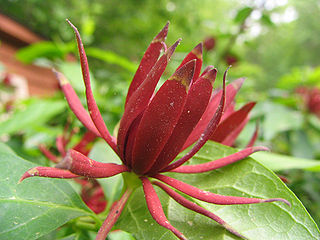
The Calycanthaceae are a small family of flowering plants in the order Laurales. The family contains three genera and only 10 known species, restricted to warm temperate and tropical regions:
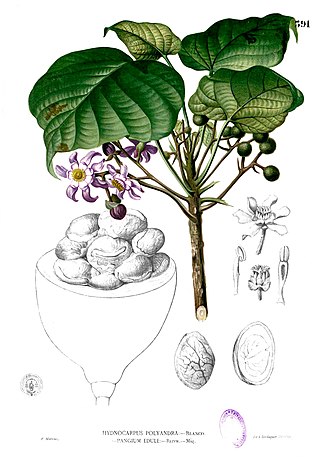
Achariaceae is a family of flowering plants consisting of 32-33 genera with about 155 species of tropical herbs, shrubs, and trees. The APG IV system has greatly expanded the scope of the family by including many genera previously classified in Flacourtiaceae. Molecular data strongly support the inclusion of this family in the order Malpighiales.
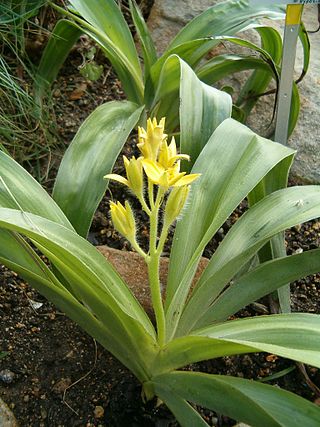
Hypoxidaceae is a family of flowering plants, placed in the order Asparagales of the monocots.

Trimeniaceae is a family of flowering plants recognized by most taxonomists, at least for the past several decades. It is a small family of one genus, Trimenia, with eight known species of woody plants, bearing essential oils. The family is subtropical to tropical and found in Southeast Asia, eastern Australia and on several Pacific Islands.

Staphyleaceae is a small family of flowering plants in the order Crossosomatales, native to Europe, temperate and tropical Asia and the Americas. The largest genus Staphylea, which gives the family its name, contains the "bladdernut" trees. The family includes three genera with more than 40 known species.
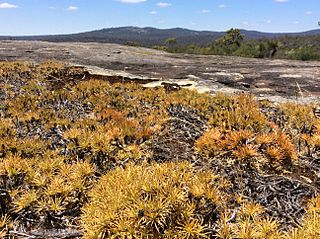
Boryaceae is a family of highly drought-tolerant flowering plants native to Australia, placed in the order Asparagales of the monocots. The family includes two genera, with twelve species in total in Australia.
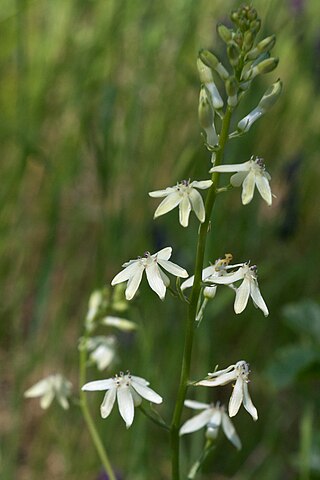
Tecophilaeaceae is a family of flowering plants, placed in the order Asparagales of the monocots. It consists of nine genera with a total of 27 species.

The Capparaceae, commonly known as the caper family, are a family of plants in the order Brassicales. As currently circumscribed, the family contains 15 genera and about 430 species. The largest genera are Capparis, Morisonia, Maerua, Boscia, and Cadaba.
Stixaceae is a family in the plant order Brassicales. It is no longer recognised by most taxonomists. The three genera formerly included in Stixaceae — Forchhammeria, Stixis and Tirania — have sometimes been placed instead in the Capparaceae, but it is now clear that they do not belong there. It is unknown where they do belong though, so currently they are unplaced at family rank. In the APG IV system, the genera comprising Stixaceae are included in the family Resedaceae.

Huaceae is a family of plant in the rosids group, which has been classed in the orders Malpighiales, Malvales, and Violales or in its own order Huales. The APG II system placed it in the clade eurosids I, whereas the APG III system of 2009 and APG IV (2016) place it within the Oxalidales. The family is endemic to central Africa. It contains four species in the following two genera:

The Anacampserotaceae are a family of plants proposed in the February 2010 issue of the journal Taxon. The family was described by Urs Eggli and Reto Nyffeler in their analysis of the polyphyly in the suborder Portulacineae. The new family and its circumscription was based on molecular and morphological data. The three recognized genera - Anacampseros, Grahamia, and Talinopsis - were formerly placed in the Portulacaceae and comprise a total of 36 known species. This family was accepted in the Angiosperm Phylogeny Group's 2009 publication of the APG III system.

Metteniusaceae are a family of flowering plants, the only family in the order Metteniusales. It consists of about 10 genera and 50 species of trees, shrubs, and lianas, primarily of the tropics. The family was formerly restricted to just Metteniusa, but it is now expanded with a number of genera that were formerly placed in the widely polyphyletic Icacinaceae.

Petiveriaceae is a family of flowering plants formerly included as subfamily Rivinoideae in Phytolaccaceae. The family comprises nine genera, with about 20 known species.
